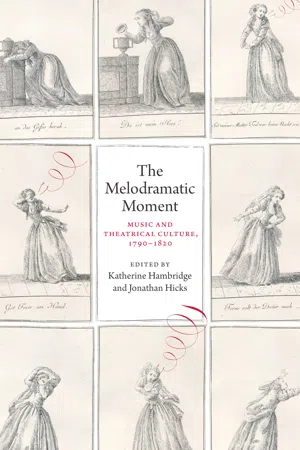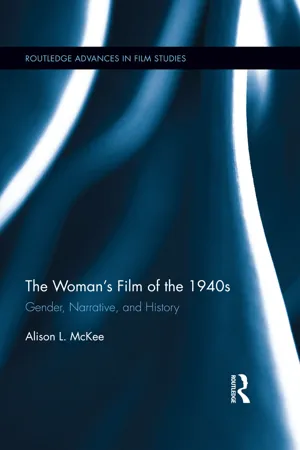Melodrama
Melodrama is a genre characterized by exaggerated emotions, sensational plots, and moral polarization. It often features clear distinctions between good and evil characters and evokes strong emotional responses from the audience. Melodramatic works typically emphasize spectacle and sentimentality, and they have been popular in literature, theater, and film, particularly in the 19th century.
7 Key excerpts on "Melodrama"
- eBook - ePub
- Warren Buckland(Author)
- 2015(Publication Date)
- Teach Yourself(Publisher)
...116–17 The genre film offers a lesson in how to act within society and how to deal with current problems and anxieties. But it does not offer neutral ways of dealing with social problems. Instead, it prescribes a preferred set of values, those of capitalist ideology, with its emphasis on the individual: the individual’s right of ownership, private enterprise and personal wealth, the nuclear family with the wife staying at home and the husband working, the necessity of conforming to moral and social laws and so on. New studies of Melodrama In the following pages we shall review the common attributes of film Melodrama and then look at recent studies that have divided up the genre of Melodrama into thinner slices. The genre of Melodrama has been exhaustively studied; see, for example, the books by Barbara Klinger, Christine Gledhill and Jackie Byars (Dig deeper). Rather than attempt to summarize this enormous body of work and repeat its conclusions, it is more beneficial to concentrate on narrowly focused studies. But first, a few general remarks. Historically, Melodrama has replaced religion as a way of thinking through moral issues and conflicts. As with religion, the function of Melodrama is to clarify ethical choices that we have to make in our lives. This is why the conflict between good and evil is central to Melodrama. But rather than focusing on the sacred, as religion does, Melodrama focuses on moral issues and conflicts as experienced by ordinary people on a personal, everyday basis. The genre of the film Melodrama is frequently defined as a woman’s genre, because it represents the questions, problems, anxieties, difficulties and worries of women living in a male-dominated, or patriarchal, society. The first and most prevalent property, or common attribute, of Melodrama is that it is dominated by an active female character...
- eBook - ePub
Compassion
The Culture and Politics of an Emotion
- Lauren Berlant, Lauren Berlant(Authors)
- 2014(Publication Date)
- Routledge(Publisher)
...Melodramatic characterization is poised on the cusp of this modern development of sociological thinking about groups and types. Still usually lampooned for the stock stereotypicality of its characters, Melodrama is in fact full of deviants and radicals. The characters are stereotyped, yes, but they are also novel figures, implicitly displayed against the background of more traditional, heroic, and tragic types. Melodramatic characterizations are like diagrams of social relation, operatically coded to a restricted repertory of social registers. They are meant to insist upon new potentialities registered by the particular postrevolutionary deviances of certain new social actors: servants whose wit exceeds that of their masters; rustic artisans with radical propensities; dashing rescuers and innocent escaped prisoners; honest sailors combating the injustices of the Royal Navy; women seduced, betrayed, violated, or abandoned who might or might not be restored to their domestic roles in the end; and, of course, illegitimate children inheriting through the machinery of the plot despite the degeneracy of their aristocratic fathers. In Melodrama, the type is foregrounded as a way of emphasizing the character’s determinate social role, whereas in novelistic realism, the character’s individuality is foregrounded but is always set against the aura of the social type. It is the form of typification alone that differs, for both work on the same modern, sociological notion that individuated forms of social life can be understood only in relation to generalized group formations. 20 In Daniel Deronda, George Eliot was obviously writing against the type of the “Melodramatic Jew” depicted in The Bells, where the avenging, otherworldly retribution for Mathias’s crime crystallizes anti–Semitically around the stereotypical image of the rich, itinerant Jew, his money belt hanging conspicuously around his waist...
- eBook - ePub
- M. Stewart(Author)
- 2014(Publication Date)
- Palgrave Macmillan(Publisher)
...1 Introduction: Film and TV Melodrama: An Overview Michael Stewart Foundations There are a number of excellent attempts to define and locate Melodrama in film studies, for example, Gledhill (1987 and 2007), Neale (2000), Williams (1998), Singer (2001), Byars (1991), Mercer and Shingler (2004) and Zarzosa (2013). To do justice to these reviews here is impossible. Instead, I will highlight those points that I consider to be important generally and to this collection in particular. The most generally valuable review of Melodrama in Euro-American film studies is the chapter on Melodrama in the BFI’s The Cinema Book (2007, pp. 316–332). This chapter summarizes the work of the theorists who, in the 1970s, brought Melodrama to prominence as a serious object of study. Melodrama here is analyzed from the point of view of auteurism and mise-en-scene; neo-Marxism; feminism; psychoanalysis; history; and genre. Geoffrey Nowell-Smith captures a number of these contours in his argument that ‘Melodrama arises from the conjunction of a formal history proper (development of tragedy, realism, etc.), a set of social determinations, which have to do with the rise of the bourgeoisie, and a set of psychic determinations which take shape around the family’ (Nowell-Smith, in Gledhill, 2007, p. 316). These founding analyses of film Melodrama differ, as Gledhill indicates (2007, p. 316), depending on what may be at stake theoretically and politically in the advancement of a particular definition. Laura Mulvey, for example, questions the validity of auteurist and neo-Marxist approaches which focus on male perspectives in family Melodrama (in Gledhill, 2007, p. 321). Equally, however, in her earliest intervention in film Melodrama debates (Mulvey, 1974), Mulvey combines a feminist approach with an argument that underlines the progressive features of Rainer Werner Fassbinder’s directorial style...
- eBook - ePub
The Melodramatic Moment
Music and Theatrical Culture, 1790–1820
- Katherine G Hambridge, Jonathan Hicks(Authors)
- 2018(Publication Date)
- University of Chicago Press(Publisher)
...But the distaste of a few should not lead us to write off the experience of the many. Following Waeber, we might explore the formal fixation on the momentary and the transitory, without necessarily relating this to any overarching structure. Musicologists have become used to reading the c. 1800 moment in terms of increasing concerns for cohesion, increasing complaints about pastiche, and increasing expectation of novelty in musical language. But in many ways Melodrama appears to be a contradiction of this model: even the supposedly “high” German examples are strangely fragmented and old-fashioned in their affective vocabulary. Perhaps the problem is not so much with Melodrama as with our models of historical inquiry. By suspending or resisting existing historical narratives (Melodramatic and otherwise) we can reopen the question of what early Melodrama might have meant to audiences and others at different times and different places. This, in turn, allows us to lead from local questions to broad reflections on music theater and early nineteenth-century aesthetics. If the period was supposedly one in which the work concept became regulative, when the authority of genius gained a decisive foothold, and the fixed text began to organize beneath it a hierarchy of actors and audiences, the Melodramatic narratives contained in this volume reveal a more complex set of stories. Since there was so much concern surrounding Melodrama, and so much written in the wake of its popular and academic success, the genre presents a unique opportunity to think again about the musico-theatrical sphere during a pivotal moment in the history of European art....
- eBook - ePub
The Woman's Film of the 1940s
Gender, Narrative, and History
- Alison L. McKee(Author)
- 2014(Publication Date)
- Routledge(Publisher)
...3 Melodrama, History, and Narrative Recovery In “Melodrama Revisited,” a reevaluation of film Melodrama and, by extension, classical Hollywood film, theorist Linda Williams reviewed the Anglo-American scholarly traditions that grew around Melodrama as a critical category within film studies and rightly observes that they tended to focus on what it usually termed an anti-realist form of expression in a cinema otherwise presumed to be realist. Williams presented “a revised theory of a Melodramatic mode—rather than the more familiar notion of the Melodramatic genre” (1998, 43) in which she asserted that “Melodrama should be viewed … not as an excess or an aberration but in many ways as the typical form of American popular narrative in literature, stage, film, and television” (50; emphasis mine). Williams’s article constituted a signal refiguring of the terms of systematic thought about Melodrama in film and an equally important and useful way of thinking about classical American narrative cinema in a larger context—that is, not as a series of simplified oppositions (e.g., realist v. anti-realist, content v. form, narrative v. spectacle) but as a multifaceted representational system with Melodrama as its very foundation. Williams continued her investigation of Melodrama as (more than) a cinematic transgeneric mode in her later work Playing the Race Card (2001), correctly arguing that “the heritage of moving picture Melodrama shapes not only fictional films and television but the media representation of war, athletic competitions, and courtroom trials” (13). She observed that “if Melodrama has been classified in film studies as a sentimental genre for women, it is partly because other Melodramatic genres, for example the western and gangster films that received early legitimacy in film study, has already been constructed, as Christine Gledhill notes, in relation to supposedly masculine cultural values (1987, 35)” (17)...
- eBook - ePub
- Marjorie Boulton(Author)
- 2014(Publication Date)
- Routledge(Publisher)
...It may have a sad or a happy ending, though the sad ending—a pile of corpses or a screaming lunatic—is perhaps more completely Melodramatic. It is distinguished from true tragedy by a portrayal of characters who are all more violently and improbably good or evil than is realistic; by a lack of real psychological insight; by a more far-fetched plot whose horrors and sensations may easily tumble over into the ludicrous; and by a continual pandering to the public desire for strong sensations and great excitement. Melodrama may also fall into sentimentality when an attempt is made to portray a tender or lofty emotion. Shakespeare's Titus Andronicus and The Jew of Malta of Marlowe are two early Melodramas, and it does not take much insight to see that these are not plays on the tragic level of Othello or Edward II It is possible, however, to dismiss a play too readily as Melodrama. There is good Melodrama, now sometimes referred to in catalogues simply as ‘drama’ or ‘strong drama’, and bad Melodrama. A dreadful example of Melodrama which at no point rings true, largely because of the artificiality of its dialogue, is George Barnwell, already quoted. Lord Lytton's The Lady of Lyons has a most improbable plot and the dialogue is not adequate to the theme, but it is not entirely without merit and might make quite a good play if sincerely performed. (I have not had an opportunity of seeing it.) W. W. Jacobs's The Monkey ’ s Paw is an example of intelligent Melodrama that is not to be despised, though it might be argued that the theme of wishes being fulfilled in such a way as to bring misery has strong tragic overtones and it is these that give dignity to the play. Quite a number of good modern plays have elements of Melodrama but are far from being without literary merit. James Bridie's Dr...
- eBook - ePub
The Novel Stage
Narrative Form from the Restoration to Jane Austen
- Marcie Frank(Author)
- 2020(Publication Date)
- Bucknell University Press(Publisher)
...Tragicomedy helped to shape the short prose fiction of Aphra Behn; it was a vehicle through which the social and aesthetic valences of tragedy and comedy were reconfigured and made available to the eighteenth-century novel, a genealogy I explore in the first part of chapter 1, “Genre, Media, and Theory of the Novel.” The comedy of manners migrated from the Restoration stage to the novel over the course of the long eighteenth century, a process I track in chapter 2, “The Reform of the Rake from Rochester to Inchbald.” The comedy of manners reached its apotheosis in Jane Austen, though the mark of the stage in her novels manifests itself in the terms of Melodrama as well, as I establish in chapter 5, “Melodrama in Inchbald and Austen.” Although the first Melodrama is often identified as Pix é r é court’s Ç oelina (1801), translated almost immediately into English by Thomas Holcroft as the Tale of Mystery (1802), stage Melodrama was conditioned by the Gothic novel—Coleridge even traced its roots back to Richardson’s Clarissa. 15 A revisionary history of Melodrama’s emergence introduces its influence on the novels of Inchbald and Austen. The Novel Stage takes advantage of the ways the history of the novel can benefit from theater studies, though it also respects their significant methodological differences. The distinction between theater and drama, between what is staged and what is read, has made performance and its histories subject to analysis in theater studies. Yet the interest in performance as a medium has served to separate drama from other literary genres; in a complementary fashion, novel studies has had eyes only for the medium of print. Despite our thoroughgoing sensitization to media since the digital turn, we have yet to acquire the most efficacious sense of its history or its interactions with terms such as “form” and “genre,” which will enable its best application to literary analysis...






